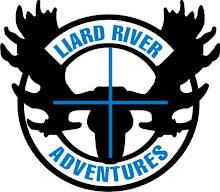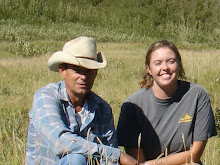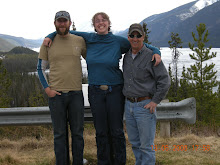I breathe in. I breathe out. It's just past midnight and I've been contemplating the differences in available phosphorous between molisols of a grassland and oxisols of the tropics. Dr. Gail Wilson sure knows how to write a challenging biogeochemistry final exam. I walked back to my residence on campus which is only 10 minutes away from my office. If I was wearing a Lotek GPS collar, my minimum convex polygon representing my home range and my kernel density estimate would be within a 500m triangular area of the depanneur/7-11, my bedroom and Ag. Hall. Dr. Bob Fenimore (veterinarian and long time family friend) and Greg Anderson (formerly provinical manager of the Ecosystem Restoration program and recently retired from the BC Forest Service as well as a mentor and good friend to me) told me 2 things:
1. "Ass in seat" - Bob Fenimore in reference to working hard, being studious and doing my work
2. "Treat it like a job" - Greg Anderson in reference to working hard, being studious and doing my work!
And I can tell both of y'all that in fact, that's what I've done this past semester and while I was walking back just now, I realized that may be the key to success as a graduate student - hard work and dedication.
My good friend Dan Dvorett, a recent PhD candidate who has just completed his Masters, hosted the annual Zoology-NREM crawfish boil at his place outside of Stillwater. I went for a couple hours to break up my final exam writing and got the opportunity to visit with my fellow grad students who have become very good friends to me. And when it was time to come back to my small home range, I realized I was sad to say good bye to these folks. It is an honour to be surrounded by some of the brightest and academically inclined folks around. People who are kind, respectful, nice and just down right good. So thank y'all all y'all for giving to me great friendship, comradery and community. You are good people and I'm honoured to know y'all.
Saturday, April 30, 2011
Tuesday, April 26, 2011
6 days to go ...
Resource ecology: the ecology of trophic interactions between consumers and their resources.
Spatial ecology: effects of space and scale on the dynamics of individual species and on the structure and dynamics of multiple species assemblages
Analysis of 13C/12C isotope ratios in soil samples from a forested hillside between Tulsa and Stillwaer are likely to reveal δ 13Cvalues of -26 per mil near the surface and δ 13C values closer to -14 per mil deeper in the soil. These values are negative because .... The most likely explanation for the change in values (less negative) with depth is ...
Recent models indicate organic N may be an important component of the N cycle as opposed to classical N cycling models that assume inorganic N is the sole source of N available to plants. Moxdzer et al. (2010) suggest that ...
Hawth's tool for Kernel Density Estimates and Minimum Convex Polygons ... ARC GIS 9.3 ... resource selection ...
Grassland bird populations are declining because of lack of appropriate habitat and the intrusion of cross fencing and shrubs onto rangelands...
Just a few of the things that are floating around in my brain today on my last Tuesday in America as I sit and try to motor through my final exam for Biogeochemistry and Global Ecology. 6 days of solid production of maps, final GIS analysis and working my way through my first scientific paper to be submitted through the summer. This semester was a 10/10 in comparison to last year in many ways. As sad as I am to leave America again, it is time to go home. I leave here with so much more knowledge of what I don't know and what I want to know, of being more skeptical than ever before, of reflecting solidly before I speak, of listening hard to all the information I am presented with, of lighting fires in my advanced prescribed burn class with John Weir. I leave here reluctantly because being in this world of rangeland science, fire ecology, in depth ecological research has become part of who I am. I know so much more about range management and ecosystem processes that I am eager to contribute back to the management of the land at home.
The journey here in America and with my PhD is almost hard to described. It's the biggest brain overload I've ever had in my life, it's being competitive with some of the most intelligent thinkers in North America and it's a lot about personal growth and development that I hope will contribute to science and management in the not so distant future!
I look forward to coming home to Canada and that just means that I will also look forward to my return for my last semester in America in the Fall of 2012... onwards!
Spatial ecology: effects of space and scale on the dynamics of individual species and on the structure and dynamics of multiple species assemblages
Analysis of 13C/12C isotope ratios in soil samples from a forested hillside between Tulsa and Stillwaer are likely to reveal δ 13Cvalues of -26 per mil near the surface and δ 13C values closer to -14 per mil deeper in the soil. These values are negative because .... The most likely explanation for the change in values (less negative) with depth is ...
Recent models indicate organic N may be an important component of the N cycle as opposed to classical N cycling models that assume inorganic N is the sole source of N available to plants. Moxdzer et al. (2010) suggest that ...
Hawth's tool for Kernel Density Estimates and Minimum Convex Polygons ... ARC GIS 9.3 ... resource selection ...
Grassland bird populations are declining because of lack of appropriate habitat and the intrusion of cross fencing and shrubs onto rangelands...
Just a few of the things that are floating around in my brain today on my last Tuesday in America as I sit and try to motor through my final exam for Biogeochemistry and Global Ecology. 6 days of solid production of maps, final GIS analysis and working my way through my first scientific paper to be submitted through the summer. This semester was a 10/10 in comparison to last year in many ways. As sad as I am to leave America again, it is time to go home. I leave here with so much more knowledge of what I don't know and what I want to know, of being more skeptical than ever before, of reflecting solidly before I speak, of listening hard to all the information I am presented with, of lighting fires in my advanced prescribed burn class with John Weir. I leave here reluctantly because being in this world of rangeland science, fire ecology, in depth ecological research has become part of who I am. I know so much more about range management and ecosystem processes that I am eager to contribute back to the management of the land at home.
The journey here in America and with my PhD is almost hard to described. It's the biggest brain overload I've ever had in my life, it's being competitive with some of the most intelligent thinkers in North America and it's a lot about personal growth and development that I hope will contribute to science and management in the not so distant future!
I look forward to coming home to Canada and that just means that I will also look forward to my return for my last semester in America in the Fall of 2012... onwards!
Wednesday, April 13, 2011
Society for Range Management - Montana 2011
 Stillwater got blasted with the worst winter storm in recent history. This is a picture looking out my dorm room to the snow drifting high outside and on my window sill. Thank goodness for space heaters from WalMart to keep me warm in my room along with many quilts and fleece pants! School was closed for a week. Temperatures dropped to below -30C. And we left to head up north to Montana in the middle of all of it ...
Stillwater got blasted with the worst winter storm in recent history. This is a picture looking out my dorm room to the snow drifting high outside and on my window sill. Thank goodness for space heaters from WalMart to keep me warm in my room along with many quilts and fleece pants! School was closed for a week. Temperatures dropped to below -30C. And we left to head up north to Montana in the middle of all of it ...A small herd of us decided it was best to drive to Montana for the 2011 Society for Range Management international meeting. It was a 21 hour drive north and a 21 hour drive back south ... with minimal stops along the way. I was looking forward to the trip so that I could see Kansas, Nebraska, Colorado, Wyoming and Montana but things didn't end out as hoped for. We travelled through the night, leaving Stillwater at midnight and arriving in Billings, Montana at 9pm the following evening. We had 3 white outs, major winds and storms, icey road conditions and a whole lot of car sickness from the Canadian in the back of the bus. It was good to get to finally arrive in Billings!
 Castle Rock, Wyoming
Castle Rock, Wyoming Welcome to Wyoming!
Welcome to Wyoming! Wyoming!
Wyoming! Winter storm on the way in Wyoming
Winter storm on the way in Wyoming Big spaces in Wyoming!
Big spaces in Wyoming!


Subscribe to:
Posts (Atom)










